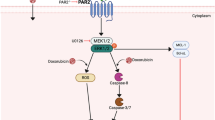Abstract
We investigated two of the major proposed modes of action of the benzoquinoid ansamycin geldanamycin using a pair of human colon-carcinoma cell lines, BE and HT29. One potential mechanism of action in colorectal cancer is the inhibition of c-Src kinase activity, since this proto-oncogene is hyperexpressed in human large-bowel tumours. Our results show that despite the 9-fold higher level of c-Src kinase activity found in HT29 cells, there was only a 1.4-fold difference in cytotoxicity as compared with BE cells, the latter being the most sensitive. Moreover, even at concentrations of geldanamycin that resulted in cell kill of 80% or more after a 24-h period of exposure, there was no effect on␣␣␣ c-Src kinase activity in HT29 cells, although c-Src protein was depleted at supralethal levels of exposure. We also investigated the metabolism of the quinone moiety of geldanamycin by DT-diaphorase, an enzyme that activates certain quinone antibiotics such as mitomycin C and is hyperexpressed in colorectal cancer cells. Geldanamycin was shown to be a substrate for␣DT-diaphorase present in HT29 cells. However, the lack of a major differential in cytotoxicity between HT29 and BE cells indicates that this is unlikely to be pharmacologically significant, since the former contains high levels of enzyme activity, whereas BE cells have no significant activity due to a point mutation in the DT-diaphorase (NQO1) gene. Although reduction of geldanamycin was also catalysed by non-DT-diaphorase reductases in HT29 and BE cells, providing the potential for free radical induction, this is unlikely to be significant since studies previously reported by us elsewhere showed that cells exposed to geldanamycin exhibited no evidence of DNA damage. Thus, as far as the mode of action of geldanamycin in human colon-carcinoma cells is concerned, the present results rule out two major possibilities, namely, the involvement of c-Src tyrosine kinase inhibition and DT-diaphorase metabolism.
Similar content being viewed by others
Author information
Authors and Affiliations
Additional information
Received: 20 April 1997 / Accepted: 5 September 1997
Rights and permissions
About this article
Cite this article
Brunton, V., Steele, G., Lewis, A. et al. Geldanamycin-induced cytotoxicity in human colon-cancer cell lines: evidence against the involvement of c-Src or DT-diaphorase. Cancer Chemother Pharmacol 41, 417–422 (1998). https://doi.org/10.1007/s002800050760
Issue Date:
DOI: https://doi.org/10.1007/s002800050760




